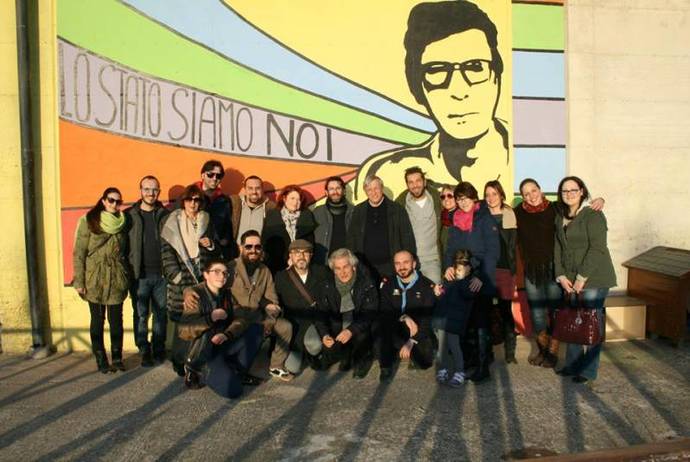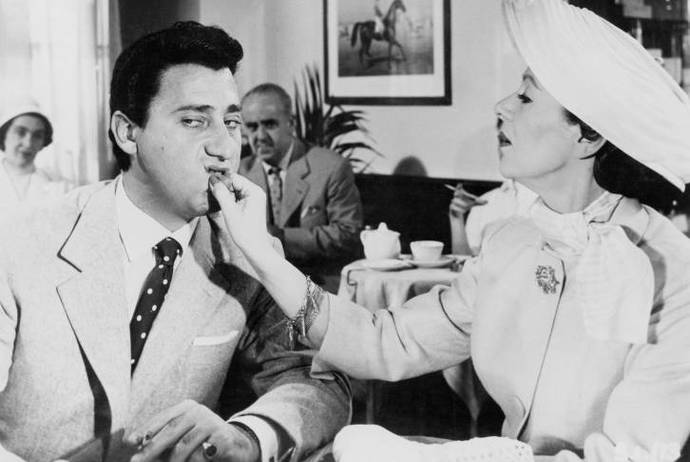Many say that Antonio Pietrangeli has been forgotten but his films, movies featuring innovative narrative structures and fine psychological analyses are here to stay and prove them wrong.
They are more than enough to earn him a prominent position in the history of Italian cinema, even though many, including the most cultured aficionados tend to bring up other filmmakers' names when talking about Italian cinema in the 1950s & 1960s.
His work falls in the category of Commedia all'Italiana, a style of Italian comedy centered on the misadventures of the unfortunate in the period of poverty that followed World War II.
The most notable names of directors representative of that cinema are Mario Monicelli, Dino Risi, Luigi Comencini, and Ettore Scola.
MoMA celebrates Pietrangeli's cinema, and a career that spans from the early 1950s to the mid-1960s with Antonio Pietrangeli: A Retrospective (December 3–18, 2015). Presented in collaboration with Luce Cinecittà, the program is organized by Dave Kehr, Adjunct Curator, Department of Film, MoMA, and Camilla Cormanni and Paola Ruggiero, Luce Cinecittà.
The program features 11 films, from Pietrangeli’s best-known work to a number of rediscoveries. The retrospective opened with his last completed film before his sudden death in 1968, I Knew Her Well (Io La Conoscevo Bene).
A comedy featuring Stefania Sandrelli, in the role of Adriana, I Knew Her Well features an apparently liberated woman who has to deal with men and career.
Maids, starlets, prostitutes, women with a lot to say but nobody who'd listen to them, women from the countryside coming to the big cities, women who try to keep up with the change of times... they all captured Pietrangeli's attention.
The aforementioned Adriana, moves from the province to the big city of Rome with the dream of becoming a celebrity. A dream Adriana had back in the sixties, when the movie was made, but that many girls still have today, and that makes Pietrangeli's cinema also “timeless.” Acting classes, fashionable parties and superficial affairs: Adriana had to deal with them, what gilr doesn't hae to deal with them now?
Pietrangeli was a major father of the Commedia all'Italiana genre but also a leading figure of Neorealism. He was among those who wanted the renewal of Italian cinema,and observed carefully what Italy was going through.He explored the ever changing role of women in Italian society after the fall of Fascism. They had to deal with a new freedom that is attractive yet at the same time ambiguous and somewhat dangerous. Adriana embodies innocence, she thinks that despite the humiliations she is going to make it. The film embodies the society’s moral double standards.
Pietrangeli was often described as “The Director who Loved Women,” as his cinema often has them at its center. The majority of films coming out at his time, films like westerns and even comedies, were more centered on male characters. Pietrangeli's profound psychological insight seemed to be more directed at women.
This transpires from the selection of films presented in the retrospective, most of them feature women looking for their spot in the world and finding their humanity.
Il Sole Negli Occhi (Empty Eyes). 1953. With Irene Galter, Gabriele Ferzetti, Paolo Stoppa.
Celestina (Irene Galter) is a naïve peasant girl who leaves her small village to look for work as a maid in Rome, where her innocence is rapidly exploited by thoughtless employers and predatory men. She places all her trust in a handsome plumber (Gabriele Ferzetti), who vanishes the minute she discovers she is pregnant. Shown with Fata Marta. 1966. With Alberto Sordi, Capucine, Olga Villi, Gigi Ballista, Anthony Steel. Pietrangeli’s episode from the omnibus film Le Fate (The Queens), which is comprised of four episodes. When Marta (Capucine) drinks too much her sex drive goes crazy and she can't keeps her hands off the new waiter and driver Antonio (Alberto Sordi).
WED, DEC 9, 4:30 T1
Lo Scapolo (The Bachelor). 1955. With Alberto Sordi, Nino Manfredi, Rossana Podestà, Virna Lisi, Sandra Milo. Pietrangeli’s second feature is a classic example of Commedia all’Italiana, starring the genre’s defining figure, Alberto Sordi, as a self-absorbed small businessman who prides himself on his dubious abilities as a ladykiller. But when the menace of loneliness finally looms, his search for a wife quickly turns desperate.
THU, DEC 10, 4:30 T1
Souvenir d’Italie (It Happened in Rome). 1957. With June Laverick, Isabelle Coreyu, Ingeborg Schöner, Massimo Girotti, Vittorio De Sica.
Three beautiful, female, foreign hitchhikers are experiencing a ravishingly idealized Italy. Along the way through the beautiful countryside, each of them encounters their fair share of amorous Latin lovers before finding true love.
FRI, DEC 11, 4:30 T1
Nata di Marzo (March’s Child). 1957. With Jacqueline Sassard, Gabriele Ferzetti, Tina De Mola, Gina Rovere.
A teenage girl (Jacqueline Sassard) falls passionately in love with an older architect (Gabriele Ferzetti), but finds she isn’t prepared for the depth of emotion and unwavering commitment of a real marriage.
SAT, DEC 12, 2:00 T1
Fantasmi a Roma (Ghosts of Rome). 1961. With Marcello Mastroianni, Sandra Milo, Eduardo De Filippo, Tino Buazzelli, Vittorio Gassman, Claudio Gora.
Life is still sweet for the aging aristocrat Prince Hannibal Roviano (Eduardo De Filippo), although he lives it alone among the ancestral ghosts who haunt the family mansion. But when the prince dies and ownership passes to his dissolute nephew (Marcello Mastroianni, in one of his three roles in the film), the ghosts must intervene to prevent the decaying palace from being turned into a disco. Their solution: recruit the ghost of a 16th-century painter (Vittorio Gassman) to whip up a hidden fresco magnificent enough to certify the building as a national treasure.
SUN, DEC 13, 5:30 T1
La Parmigiana (The Girl from Parma). 1963. With Nino Manfredi, Catherine Spaak, Salvo Randone.
Forced to leave her village because of a scandalous love affair with a seminarian, Dora (Catherine Spaak) looks for work and refuge in Parma, where she becomes involved with a petty criminal (Nino Manfredi).
MON, DEC 14, 4:30 T1
Il Magnifico Cornuto (The Magnificent Cuckold). 1964. With Claudia Cardinale, Ugo Tognazzi, Bernard Blier, Michèle Girardon, Gian Maria Volonte.
A happily married businessman (Ugo Tognazzi) allows himself to be seduced by the wife of a colleague—a meaningless affair that makes him realize how easy it would be for his young and beautiful wife (Claudia Cardinale) to betray him as he betrayed her. His unfounded suspicions grow into madness, as he obsessively imagines her in the arms of other men.
TUE, DEC 15, 4:30 T1
La Visita (The Visit). 1963. With Sandra Milo, François Périer, Mario Adorf.
Adapted from a story by Carlo Cassola (La ragazza di Bube), Pietrangeli’s exquisite miniature describes the daylong encounter of two would-be lovers who meet through a lonely-hearts ad. Adolfo (François Périer) is a fussy Roman bookstore clerk who travels to the Po Valley to meet Pina (Sandra Milo), who works for an agricultural supply firm. Worried that their marriageable days are coming to an end, the two have already decided to fall in love with each other—but first they have to get acquainted.
WED, DEC 16, 4:30, T1
Adua e Le Compagne (Adua and Her Friends). 1960 With Simone Signoret, Sandra Milo, Emmanuelle Riva, Marcello Mastroianni.
Reluctantly liberated when a reform movement closes the legal brothels of Italy in 1958, four Roman prostitutes (Simone Signoret, Sandra Milo, Emmanuelle Riva, and Gina Rovere) are forced to take their work underground, opening a restaurant on the outskirts of the city that will, under the orders of their shady sponsor (Claudia Gora) serve as a front while they practice their former profession in the rooms upstairs. But the restaurant proves to be a success, and the women find new loves and new happiness—until the sponsor decides that respectability isn’t profitable enough.
THU, DEC 17, 4:30 T1
Io La Conoscevo Bene (I Knew Her Well). 1965. With Stefania Sandrelli, Mario Adorf, Jean-Claude Brialy, Nino Manfredi, Ugo Tognazzi.
Pietrangeli’s best-known film stars Stefania Sandrelli as the 15-year-old winner of a provincial beauty contest. She’s a hairdresser who arrives in Rome as the protégé of a dubious promoter (Nino Manfredi) and finds herself drifting from man to man as she circles the periphery of modeling and show business. Indifferent to her own exploitation, she experiences a measure of material success without understanding what, if anything, she wants from life.
FRI, DEC 18, 4:30 T2






































